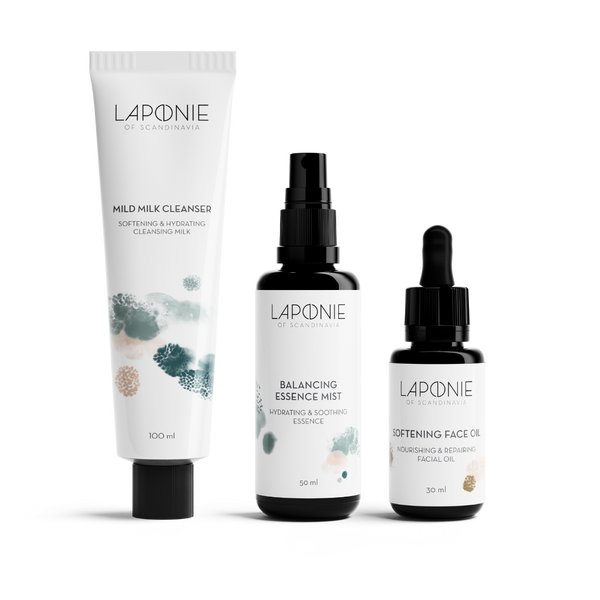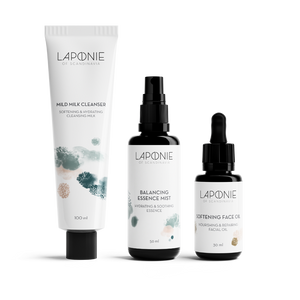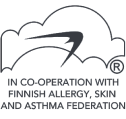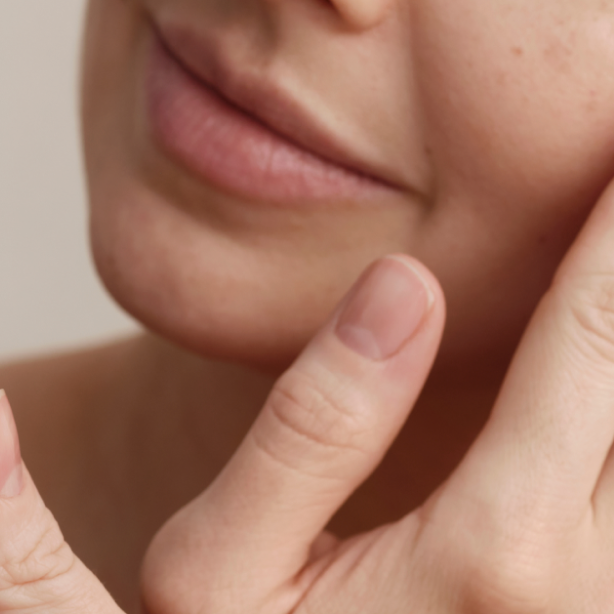
Recovery Routine for Sensitised & Reactive Skin
- Our go to routine when sensitive and problem skin needs a complete reset.
- A routine is a consistent way of caring for your skin, every day.
- Formulated for sensitive & problem skin without added fragrance.
-
Free sample with all orders.
-
Delivery: Finland 1-4 business days & rest of EU 2-7 business days.
-
Free delivery: Finland orders over 38€ & rest of EU 58€.
-
Safe payments.
Laponie's Recovery Routine for Sensitised & Reactive Skin is a three-step daily routine to cleanse, hydrate, nourish and rehabilitate sensitive and problem skin which is easily upset, can't handle traditional creams or emulsifiers, or is just out of balance.
This routine is our founder Kristina's go-to: "I love how I can play around with the amount of Essence and Oil depending on what my skin needs. When e.g. my seb derm acts up, making my skin oily and flaky at the same time, I go high on the Essence, i.e. hydration, and lower on the Oil, i.e. emollients, and when my skin tends towards more dry, I slather on the Oil to lock in hydration and keep my skin soft."
Mild Milk Cleanser
Aqua, Canola Oil, Glycerin, Polyglyceryl-3 Dicitrates/Stearate, Sodium Levulinate, Cetyl Alcohol, Sodium Anisate, Xylitol, Xanthan Gum , Citric Acid
Balancing Essence Mist
Aqua, Ectoin, Glycerin, Sodium Levulinate, Potassium Sorbate, Dehydroacetic Acid, Macrocystis Pyrifera Extract, Dipotassium Glyhyrrhizate, P-Anisic Acid
Softening Face Oil
Argania Spinosa Kernel Oil, Avena Sativa Kernel Oil, Rosa Canina Fruit Oil, Rubus Idaeus Seed Oil
Aqua
Solvent. Water. The main vehicle for our water based products
Canola Oil
Emollient and skin conditioning. Sustainably produced, deodorized and purified Swedish canola oil (from rapeseed oil) gently dissolves makeup and dirt. Canola oil is commonly used in cosmetics and is well-tolerated, skin wise. It is slightly higher in oleic acid (at around 60%), with linoleic and alpha-linolenic acids at a total of just over 30%, making it a good all-around oil for most, and especially for drier and eczema prone skins.
Glycerin
Humectant and skin protecting. Technically a sugar alcohol, glycerin is one of the oldest, most common and most versatile humectants used in cosmetics. It moisturises and protects the skin, accelerates skin barrier recovery and has antimicrobial properties, among other things. For our Cream we use vegetable, rapeseed-derived glycerin.
Polyglyceryl-3 Dicitrates/Stearate
Emulsifying and surfactant. An emulsifier, put simply, enables the mixing of water and oil into an emulsion. This particular one is gentle on the skin, non-ionic, based on glycerin, stearic acid and citric acid, and is made from rapeseed and RSPO certified palm oils.
Sodium Levulinate
Skin conditioning and preservative. Sodium levulinate is the sodium salt of levulinic acid, which is an organic acid derived from in this case sugarcane.
Cetyl Alcohol
Thickening and emulsion stabilising. A fatty alcohol made from RSPO certified palm oil. Please note that like sugar alcohols, e.g. glycerin or xylitol, fatty alcohols are not the same as denatured alcohol (ethanol); both sugar alcohols and fatty alcohols have moisturising and conditioning properties, whereas denatured alcohol has a completely different function in skincare products (and can be drying on skin).
Sodium Anisate
Antimicrobial, flavouring agent and preservative. The salt form of star anis derived organic acid. The other half of our preservation system.
Xylitol
Humectant and skin conditioning. Xylitol is a sugar alcohol and moisturises and conditions skin, whilst possessing anti-bacterial properties. There is some interesting research that suggests xylitol has the ability to inhibit bacterial biofilm on skin, which in turn may be the cause of many skin issues. The one we use is made in Finland from Finnish oats, and has probiotic properties.
Xanthan Gum
Thickening, gel forming and emulsion stabilising. A natural and commonly used mainly thickener and gelling agent in cosmetics, xanthan gum is a polysaccharide produced through Bacterial fermentation of pure culture Xanthomonas Campestris with protein and carbohydrate sources, in this case from soy or corn. In our Cream, it is combined with sclerotium gum, lecithin, pullulan and silica to lend that lovely gel meets cream feel.
Citric Acid
Buffering agent. Citric acid is a commonly used buffering, i.e. pH adjusting, agent in cosmetics. It is made through bacterial fermentation and shifts the pH of the product into the acidic range. This is closer to the natural pH of the skin, which may range from 4 to 7, but is usually thought to be between 5 and 6, with recent studies, however, indicating it to be below 5.
Aqua
Solvent. Water. The main vehicle for our water based products
Ectoin
Skin conditioning. Ectoin is a powerful, small, multi-tasking and natural stress-protection molecule, a so-called extremolyte. From a chemical point of view, it is a cyclic amino acid derivate. Extremolytes protect extremophilic microorganisms and plants from the extreme conditions of their habitats like salt lakes, hot springs, permanent ice or deserts. The properties of ectoin have been proven by various in-vivo studies: its benefits include long-term moisturisation, diminished skin roughness, skin barrier repair and anti-inflammatory and anti-irritant properties. We get ours from a lovely little company in Germany, where it is produced through biotechnological fermentation from a specific, non-GMO strain of the halophilic bacteria Halomonas elongata.
Glycerin
Humectant and skin protecting. Technically a sugar alcohol, glycerin is one of the oldest, most common and most versatile humectants used in cosmetics. It moisturises and protects the skin, accelerates skin barrier recovery and has antimicrobial properties, among other things. For our Cream we use vegetable, rapeseed-derived glycerin.
Sodium Levulinate
Skin conditioning and preservative. Sodium levulinate is the sodium salt of levulinic acid, which is an organic acid derived from in this case sugarcane.
Potassium Sorbate
Preservative. Potassium sorbate is widely used in a variety of foods and personal care products. It works by inhibiting the growth of molds, yeasts and bacteria to preserve the freshness and quality of foods, beverages, or cosmetic products. Potassium sorbate is the potassium salt of sorbic acid, which is naturally occurring in some berries, although virtually all of the world's production of sorbic acid, as well as potassium sorbate, is manufactured synthetically. Together with sodium levulinate, dehydroacetic acid and p-anisic acid it makes up the preservative system in our toner.
Dehydroacetic Acid
Preservative. Dehydroacetic acid is chemically synthesized through a multi-step reaction, starting with acetylene. Although it is not plant derived, it is approved by natural certification institutes such as COSMOS thanks to its mildness to the skin and body, as well as the absence of any alternative registered (approved) natural preservatives under the EU cosmetic regulation. Together with potassium sorbate, sodium levulinate and p-anisic acid it makes up the preservative system in our Essence.
Macrocystis Pyrifera Extract
Skin conditioning. Giant kelp. Macrocystis pyrifera is a species of kelp, and is one of the fastest growing organisms on Earth. It smooths and hydrates skin, with some studies indicating it has the ability to improve collagen synthesis and maintain skin elasticity. The kelp we use comes from South America.
Dipotassium Glyhyrrhizate
Humectant and skin conditioning. Another skincare multi-tasker, dipotassium glycyrrhizate is the dipotassium salt of glycyrrhizic acid derived from liquorice root. It improves the appearance of dry or damaged skin by reducing flaking and restoring suppleness, and possesses anti-allergic and anti-inflammatory properties. Studies also suggest it inhibits the skin’s tyrosinase activity and melanin production, making it an agent against hyperpigmentation. And if that’s not enough, further studies have demonstrated that the salt aids in reducing the redness and irritation associated with rosacea, psoriasis and acne. This one is made in Japan.
P-Anisic Acid
Masking. Star anise derived, mild and skin friendly organic acid. We use it to boost our preservation system and also to regulate the pH of our toner. It also exhibits anti-inflammatory properties. Together with sodium levulinate, potassium sorbate and dehydroacetic acid it makes up the preservative system in our Essence.
Argania Spinosa Kernel Oil
Emollient and skin conditioning. Argan oil. A staple for us. It is obtained from the non-roasted organic kernels of Moroccan Argania Spinosa, i.e. argan nuts. We love it in almost everything, and especially like its repairing qualities. It is slightly higher in oleic acid, but is usually suitable for clog prone skin, as it contains a fair amount of lupeol, a triterpenoid with anti-inflammatory benefits.
Avena Sativa Kernel Oil
Skin conditioning. Oat kernel oil. This dark golden oil has a nearly 50/50 balance of oleic and linoleic acids. From a skincare point of view, it's an excellent skin softener and has some calming properties too. We source our oat oil from Fazer, a Finnish family-owned, 126-year-old food and food service company, who produce their oil in Finland, using Finnish oats. The Finnish-ness matters because a) the soil in Finland produces outstanding quality oats and b) it is quite rare for an oil producer to have a 100% local supply chain. Markku, who is head of R&D at the oat mill in Lahtis, tells us he has personally eaten all oat products that Fazer makes – including the oil.
Rosa Canina Fruit Oil
Emollient and skin conditioning. Rosehip oil. It is rich in linoleic acid and provitamin a, which lends it regenerative properties. It can be beneficial in treating acne, rosacea and pigmentation. Coldpressed and organic.
Rubus Idaeus Seed Oil
Emollient and skin conditioning. Raspberry oil. It contains a large amount of linoleic and alpha linolenic acids, along with vitamin e. Among its central benefits is its ability to soothe skin. Raspberry seed oil may also be useful for treating eczema. Coldpressed and organic.
How to use this bundle
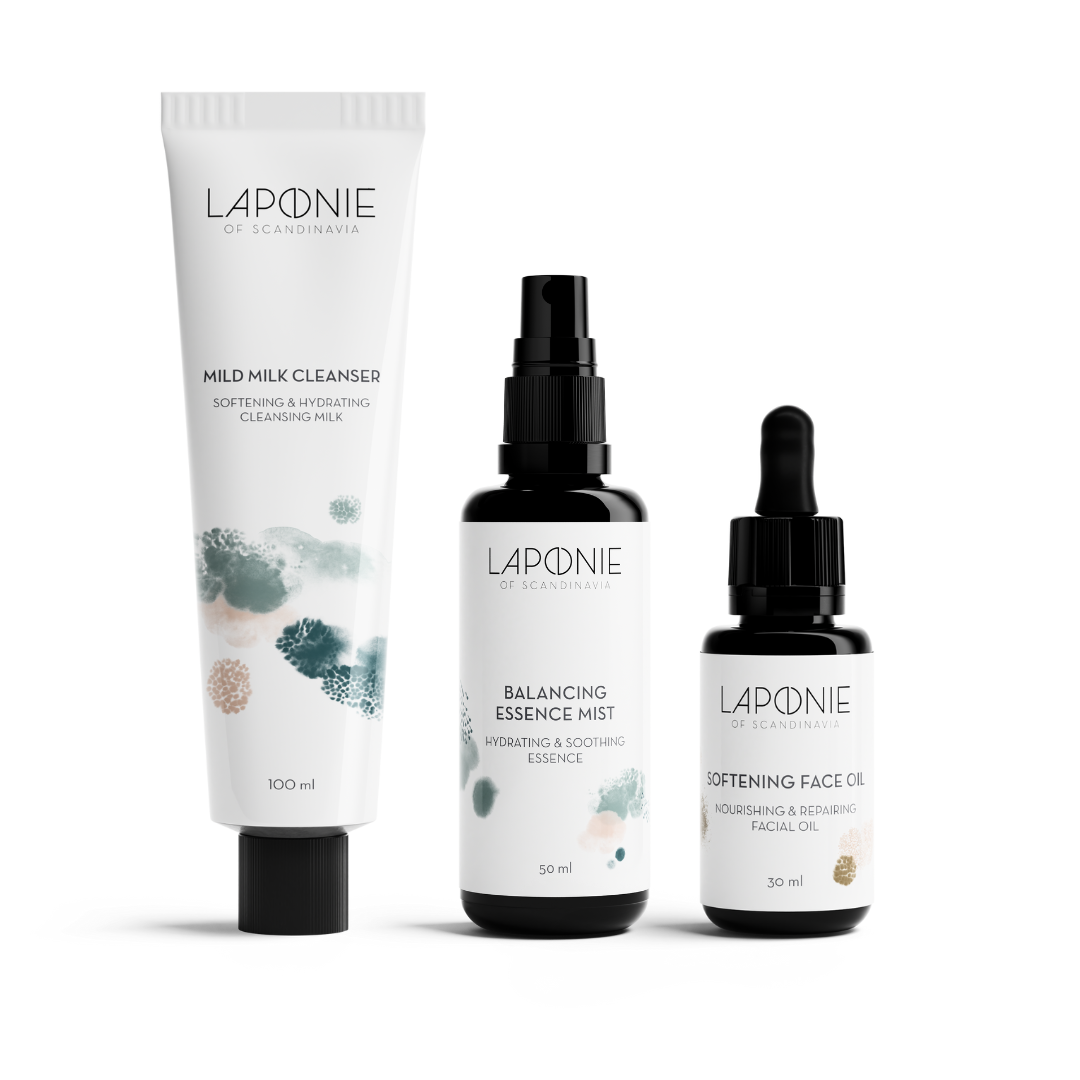
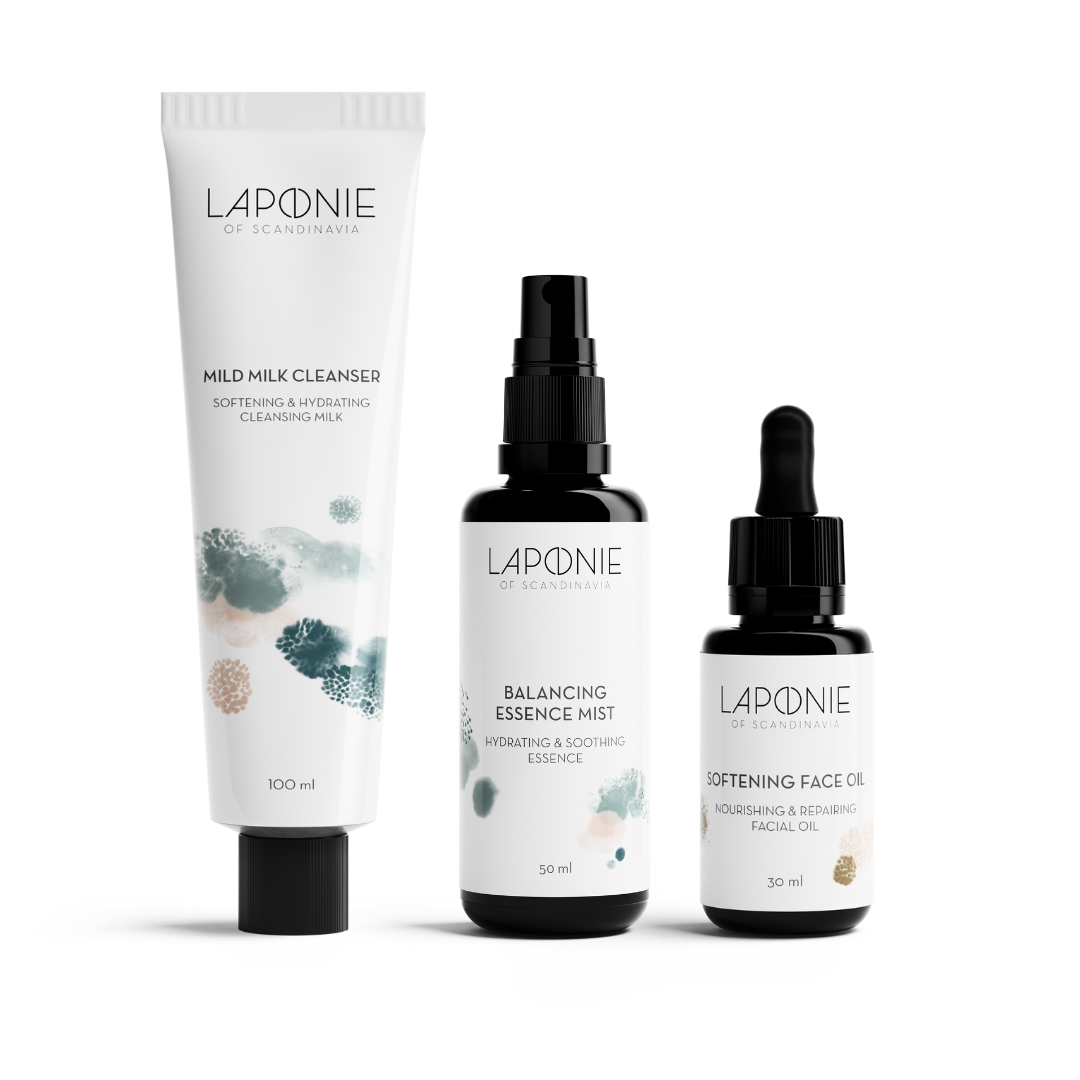
1. Cleanse
Massage a generous coin-sized amount of Mild Milk Cleanser onto dry skin with dry fingers without using water, then rinse and pat skin dry. For a deeper cleanse, e.g. for makeup, wipe off with a damp wash cloth or apply the Milk with cotton pads and wipe off face, then rinse. Can be used around the eyes.
2. Hydrate & treat
Mist clean skin with 2-3 spritzes of the Balancing Essence to hydrate and soothe. Can be used around the eyes.
3. Nourish & protect
Lightly pat a few drops of our Softening Face Oil onto skin directly after Mist, while skin is still moist. Don't rub, to avoid pilling - instead apply with sweeping motions and then pat. Drier skins usually need 3-4 drops while oilier skins can make do with 1-2 drops. Can be used around the eyes.
Formulated for sensitive & problem skin in our own lab
Our owners, CEO Kristina and cosmetic chemist Jaana, formulate all our products in our Helsinki lab, and test them on themselves - both have a long history of sensitive and problem skin.
No added fragrance
No added fragrance or essential oils, floral waters, alcohol and sulphates (including SLS).
Allergy-labelled
All our products carry the Finnish Allergy, Skin and Asthma Federation's independent Allergy-label.

